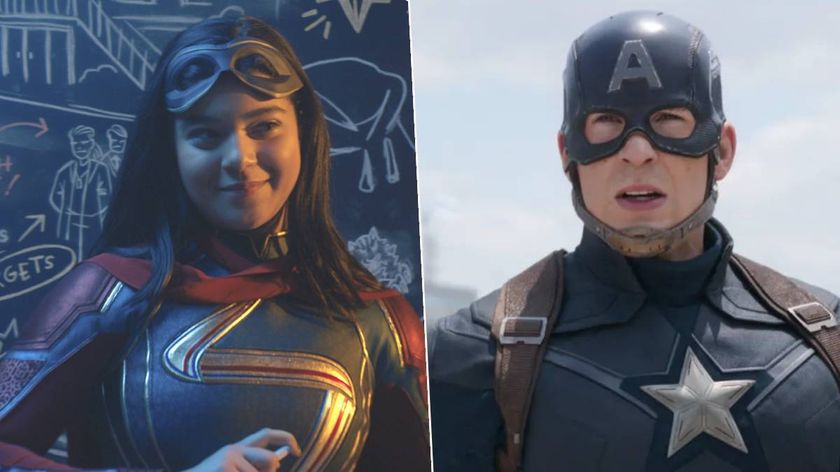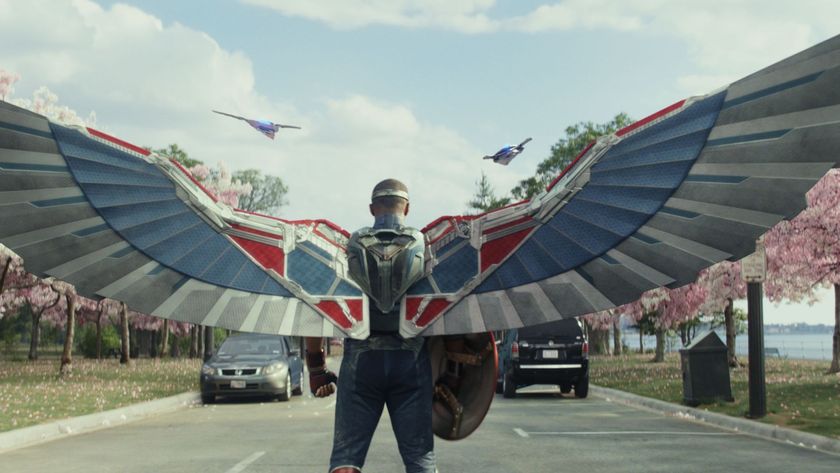Joss Whedon talks tough expectations with Avengers: Age of Ultron
It’s not only Avengers who need to assemble. Just now Joss Whedon is craving some urgent reassembly himself. “I’m totally broken.” It’s early February and Whedon’s days – and, no doubt, his every surge of nocturnal brain activity – are consumed by finessing the final cut of Avengers: Age of Ultron, an oncoming multiplex juggernaut whose spit-and-polish budget could conceivably bankroll a fistful of indie films.
“We’re at the insane-o-stage. I think we’re just about to come out of the insane-o-stage and into the ‘Hey, this looks like a movie!’ stage. I believe that it’s starting to come together.”
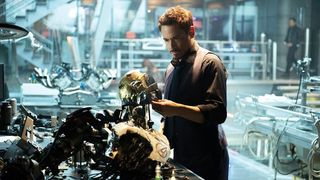
Need a working definition of the word pressure? Try this. Age of Ultron is the sequel to a film that not only made a towering $1.5 billion at the global box office – the kind of haul that only top-tier supervillains would climb out of bed for – but also rewrote Hollywood’s rules of engagement. It was the pay-off to the bold, franchise-mashing masterplan that Marvel launched with 2008’s Iron Man and its success forged new laws of box office physics. Now every studio wants a shared universe to call its own. And the world, inevitably, wants another Avengers movie, even bigger and better than the last. Once the king of cult TV fare like Firefly and Buffy The Vampire Slayer, Whedon is now the man who has to give the world Titanic 2. Only, you know, Hulkier.
“It’s liberating in the sense that there’s a certain amount of trust,” says the New York-born writer/director, all too aware he’s following a phenomenon, let alone trying to top it. “And it’s absolutely paralysing if I ever think about it. And usually I don’t. Every now and then I think about how successful the first one was and then I have to lie down for a month. So it gets me in a way that it usually doesn’t. But I’d be kind of insane if it didn’t.

“You know, I’m not trying to make the same movie. Obviously I want it to be successful. I want people to like it. I want them to have the same kind of fun they had the first time around. But I’m definitely not trying to recreate the exact same thing. I feel really good about where we’re going with it. Let’s just hope that I’m not totally wrong!” Set in an edgier, post-SHIELD landscape, the fifth film in Marvel’s Phase Two campaign finds Earth’s mightiest heroes confronting personal challenges as much as the obligatory high stakes, globe-threatening villainy. “What drives this story is the idea of power and connection, and how the more you have of one the less you have of another,” says Whedon, “and the idea of heroes and whether or not that’s a useful concept. I know it seems like we’ve heard that before but I feel that this movie makes an argument that is worth listening to.
“It’s about damaged people, because [sing-song voice] guess what I like to write about! And it’s about trying to find some kind of connection, because the Avengers are the most isolated people in the world. They’re different to everyone else. They’re richer, or stranger, or they’re monsters or they’re gods. Not one of them is really a part of the world. And this movie kind of drags them back down to Earth a little bit, which is both painful and exciting.”
The movie’s trailer – which won an internet-melting 34.3 million views in 24 hours – sold the sequel as an altogether darker proposition to its bright-eyed predecessor, packing an apocalyptic chill that promised a distinctly new flavour for Marvel. “The tone has changed somewhat,” agrees Whedon, who’s cited The Empire Strikes Back and The Godfather 2 as tonal touchstones for this movie. “It is a little grittier. We get to dig a little deeper. Introductions have been made. Now we really get to spend time not just with but inside these characters. But at the same time – am I not gonna make jokes? I don’t think so! Hopefully it’s still got that same lightness that the other one had. Obviously you don’t want to throw the baby out with the bathwater and be like ‘I hate the Avengers!’ in the second one. But you can’t do another shawarma tag. You just don’t go there. You have to find a new way to make the audience come out amazed and dying to go back in.”
Sign up to the SFX Newsletter
Get sneak previews, exclusive competitions and details of special events each month!
Age of Ultron steals its name from a recent comic book series but takes its inspiration from over 40 years of Marvel lore. Ultron, its deranged AI antagonist, was first unleashed in the pages of The Avengers in 1968, the creation of Henry Pym, alias micronautical crusader Ant-Man. Age of Ultron rewires the origin tale to make Tony Stark and Bruce Banner the hi-tech Frankensteins responsible for the creature’s birth.
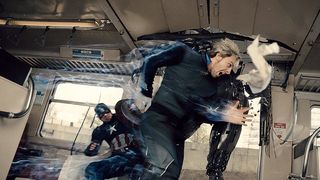
Whedon always wanted the crazed machine messiah for the Avengers sequel. “You know, he’s really been a mainstay of The Avengers, but for me it’s a robot who’s angry. And that was a gateway for me to a robot who’s completely irrational. I wanted to write a robot that we really haven’t seen in this kind of movie, who can basically talk all the logical robot things, but then has hissy fits! He also has a real perspective on who the Avengers are, and a real beef with them. He’s not a straw man. The thing that worked about Loki was that he was able to get inside everybody’s head a little bit, and Ultron, he’s got the same thing. He knows pretty much everything there is to know about these guys. The only way you can attack Earth’s mightiest heroes is from within.”
Whedon resisted the urge to return to the original comics during the screenwriting process. “I didn’t go back to them at all,” he tells SFX. “You know, he was an angry robot [laughs]. Angry all the time! That’s one of the things that drew me to him – this guy’s angry! Angry for like 50 years! You know, they reinvented him in Ultimates and stuff. At one point he was a beautiful woman… I’m not doing that one! I loved him when I read the comics as a kid, because of the scope and the sci-fi and what the team was going through, but I never looked to Ultron himself in the comics for why I love Ultron. I had an idea that I sort of extrapolated from that, so in that way he’s sort of a new guy.
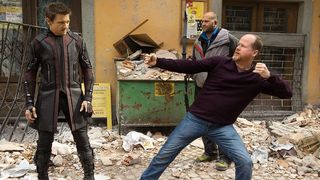
“But he’s been a tricky one to nail down. Not because the voice eluded me, but just in terms of ‘How much of his agenda is he revealing? How much of his agenda does he even understand?’ And then of course there’s the inevitable over-explaining that we do in these things, where you’re watching and you’re like ‘Okay, he said it enough, people know!’”
This Ultron is conjured with the kind of big-screen digital firepower that would fry the circuits of his comic book ancestor. James Spader mo-capped the performance and lends the creature a voice that oscillates between silky malignancy and ranting insanity. “Everything I’ve ever given to Spader he’s just knocked out of the park,” enthuses Whedon. “But – and James and I talked about this – every now and then he’ll have to do a non sequitur. And James is like ‘I have to pull out this emotion from something that’s not happening in this scene!’ But that’s who Ultron is. He’s clicking on all these different cylinders. And James really took to it. It means that you can pretty much say anything sometimes! He’s very much en scene, but at the same time, if he doesn’t have a little bit of free associative lateral now and again, he’s not going to be as much fun.”
"I long for the simple movies like Serenity! This is the hardest juggling act I have ever, ever tried to pull off."
Age of Ultron expands the already crowded ensemble cast of the first film, adding Elizabeth Olsen as hex-hurling sorceress the Scarlet Witch and Aaron Taylor-Johnson as her super-speedster sibling, Quicksilver. Whedon has the challenge of servicing every character in the fast-multiplying ranks of Avengers. “Shoot me in the face,” he sighs. “It is a nightmare. I long for the simple movies like Serenity! This is the hardest juggling act I have ever, ever tried to pull off. But everybody is really different, and the way in which you service everybody is therefore different. It’s not like well, here’s this juicy line – who gets it? That’s not how it works. Everything has to come from character. And they’re very disparate characters. The joy of the Avengers is they really don’t belong in the same room. It’s not like the X-Men, who are all tortured by the same thing and have similar costumes. These guys are just all over the place. And so it’s tough. Honestly, this is as tough as anything I’ve ever done, and I haven’t worked this hard since I had three shows on the air.”
Also added to the roster is Paul Bettany, promoted from the voice of Tony Stark’s online aide de camp JARVIS to the role of inscrutable android the Vision, an enigmatic new player spawned by Ultron himself. “Once again he’s someone who’s completely different than anybody else in terms of his powers, his look, but also his perspective. He’s artificial life and he’s not caught up in the in-house bickering and the pain and self-doubt. He shows up and he’s very certain. But we’re not certain what he’s certain of! And Paul’s great, because he’s so gentle, so compelling, but at the same time you’re like ‘[scaredy-cat voice] He’s nice but… what if he murdered me?’”
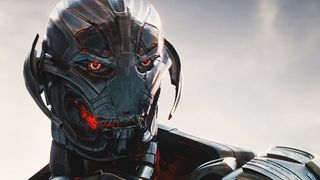
Of course Whedon knows that a certain “enormous green rage monster” stole 2012’s The Avengers. Is the Hulk a character you have to use sparingly? Or is there a temptation to go crazy with him as a surefire crowdpleaser?
“There is more Hulk in this movie than there was in the last one. But what I’m excited about is we shot this movie very differently. I was running a lot of cameras, I was shooting long lenses, which I don’t usually do. I basically went in saying we’re going to shoot it just a little bit like a documentary about the Avengers. And obviously there are splash frames and hero shots – those are the reasons you go to a superhero movie. But at the same time I wanted to get a more lived in – and what turned out to be a more gorgeous – feel to the thing. What I love is we have the opportunity, because we went in with this mission statement, to shoot the Hulk like a character in a movie, and not like a ‘Look what we’ve got!’ We have ‘overs’ – blurry ‘Hulk’s over there!’ bits, very quick shots. Everything isn’t ‘We built this Hulk so for god’s sake you’re going to watch him in this long take, full frame, the whole time!’ We really got to make him one of the characters in the movie. And that was a gift.”
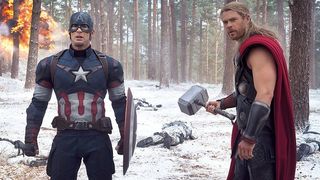
From its opening assault on the castle lair of Hydra’s Baron von Strucker to a city-bruising showdown between the Hulk and Tony Stark, rigged out in mecha-steroidal Hulkbuster armour, you wonder if there’s a moment in Avengers: Age 0f Ultron where Joss Whedon, lifelong comics junkie, can ever tune out the world’s expectations and wallow in the pure fan joy of the visions he’s bringing to the screen.
“Oh, there’s more than one!” he says, without hesitation. “Honestly. We screened the movie last night, and just to sit down and watch it, which is not something you really get to do at this stage… I was like okay, some of this is the bomb. Some of this is really, really lovely. The actors are killing it, the sequences are exciting, the editors are amazing and Ben Davis, who shot it, has made it a work of art. There are some hardcore action sequences in this but what’s really grand is how the characters play through those. It’s always got to be about the people. Not just the smaller moments, where they’re talking alone, but the way they’re interacting during the action is really exciting for me.
“I’m a people person,” deadpans Whedon. “Unless I’m in an actual room with people…”
Click here for more excellent SFX articles. Or maybe you want to take advantage of some great offers on magazine subscriptions? You can find them here.

Nick Setchfield is the Editor-at-Large for SFX Magazine, writing features, reviews, interviews, and more for the monthly issues. However, he is also a freelance journalist and author with Titan Books. His original novels are called The War in the Dark, and The Spider Dance. He's also written a book on James Bond called Mission Statements.
Most Popular





